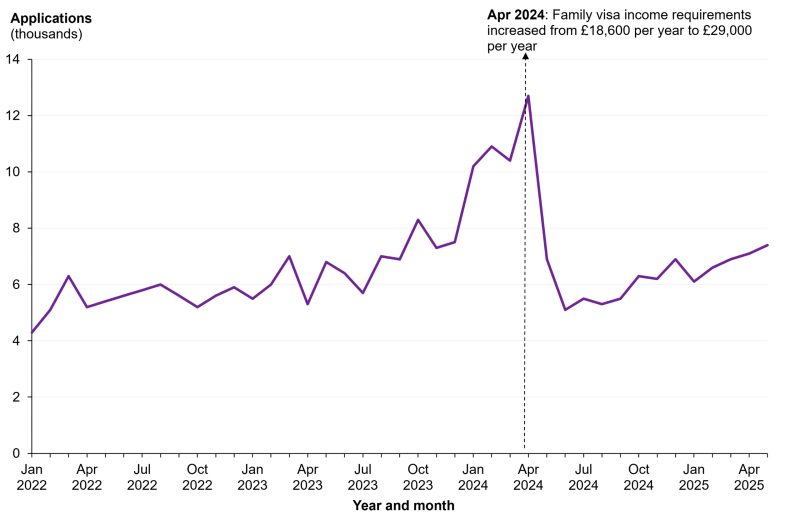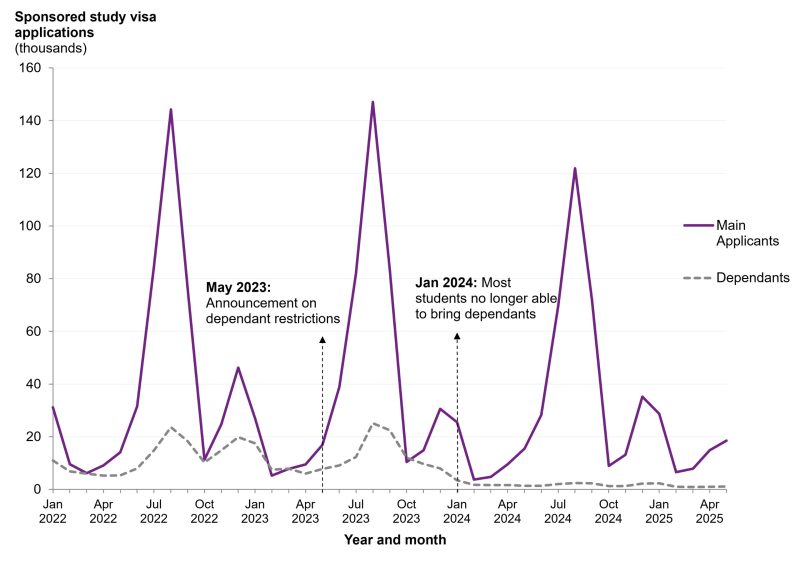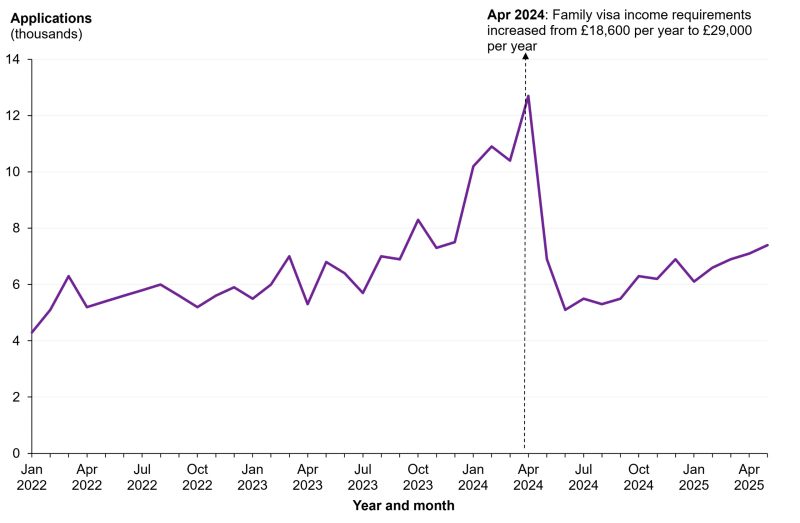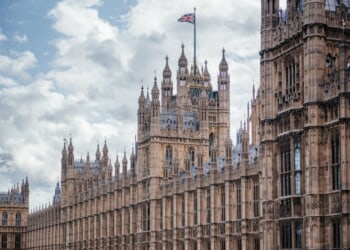The Office for National Statistics (ONS) recently released immigration and emigration figures for the year ending December 2024. The ONS estimates that 948,000 people entered the UK, with 517,000 leaving, resulting in a net-migration figure of 431,000.
Since Labour entered office, they haven’t made any changes to visas, salary thresholds or other criteria that would reduce legal migration; however that hasn’t stopped them taking credit for the reduction.
The recently announced fall in net-migration can be attributed to changes that were brought in by Rishi Sunak’s Government in the first half of 2024, these included:
- From 1 January 2024 – Most overseas students were restricted from bringing family members (dependants) with them.
- From 11 March 2024 – Care workers were restricted from bringing dependants with them and all care providers sponsoring migrants were required to register with the Care Quality Commission.
- From 4 April 2024 – The salary threshold for those on the Skilled Worker visa was increased from £26,200 to £38,700.
- From 4 April 2024 – The Shortage Occupation List was replaced with a new Immigration Salary List and the 20 per cent going rate discount was abolished, this meant that employers could no longer pay an immigrant worker less than they could a British worker in occupations on the shortage list.
These policy changes have led to a substantial reduction in the number of visa applications, which are published and updated every month here, with the most recent release covering May 2025.

After these changes were introduced, applications under the health and care visa have fallen substantially and applications under the skilled worker visa have fallen as well, though in recent months, applications for dependants have been increasing.
One of the big drivers in the net-migration figure falling nearly 50 per cent from the 2023 peak of 906,000 will be fewer dependants and workers on the health & care visa. When this visa route was first introduced, it didn’t impose any restrictions on the number of dependants a worker could bring with them. Between January 2021 and June 2024, 647,134 people have entered the UK under this visa route, with 58 per cent being dependants and the remaining 42 per cent the workers.
We can also see a reduction in the number of international students applying to study in the UK, though this decrease is not as pronounced as what can be observed with work visas. It will be interesting to see how study visa applications fare between July and September, as this is when they tend to spike.

Another one to watch is the number of family visas applications, they dropped when the minimum income for family visas was increased to £29,000 from £18,600, but have slowly been creeping up again, largely the result of refugee family reunion applications, and many of those who enter the UK illegally via small boat get their asylum application approved and can later bring over their spouse and children, effectively chain migration.

Rishi Sunak became Prime Minister in October 2022, one must ask why the Conservative Government didn’t bring these changes in sooner, perhaps if they did, the Conservatives wouldn’t have suffered as big a defeat at the 2024 General Election as they did.
For 2022, net-migration was initially estimated to be 606,000, this was later revised upwards to 745,000, then it was revised upwards again to 764,000, before being revised upwards a third time to 872,000; over an 18-month period, the figure was revised upwards from 606,000 to 872,000, an increase of 44 per cent.
2023 was no different, the ONS initially estimated net-migration in 2023 at 740,000, which was later revised upwards to 906,000, an increase of 22 per cent, not as big an increase as the upwards revisions in 2022, but still a substantial increase.
It is for this reason the ONS net-migration figures should be taken with a pinch of salt, in recent years, it’s become a common occurrence for these figures to be revised upwards, often to the tune of hundreds of thousands.
Even if the net-migration figure for 2024 stands at 431,000 and doesn’t get revised up, this is still too high, this would be the third highest net-migration figure on record, behind only 2023 and 2022, would be 100,000 higher than the year prior to the EU referendum and is the equivalent of needing to build a city the size of Bristol every year to keep up with population increase, which given birth rates in recent years, is almost entirely driven by immigration.
The Government’s recently announced immigration white paper includes additional reforms, that if implemented, would reduce immigration further, some of the highlights include:
- Skilled workers should have a university level degree
- The immigration skills charge will rise by 32 per cent
- The social care visa will close to new applicants from 2028
- Tougher requirements to sponsor international students
- Higher English language requirements for workers & their dependants
- Increasing the qualifying period of Indefinite Leave to Remain (Settlement) from 5 years to 10 years
The technical annex document estimates the proposals in the white paper would reduce inflows by around 100,000 per year, so would theoretically reduce this further from 431,000 to 331,000, which is still higher than pre-Brexit and many will argue net-migration hovering around 250,000 – 300,000 per year is still too high.
Recent polling has shown that over 85 per cent of the UK public want net-migration to be below 100,000 per year in some fashion, with 23 per cent backing net-zero immigration and 23 per cent also backing ‘less than zero’ immigration, meaning more people would leave the UK than enter, as was the case throughout much of the 1960s to mid-1980s.
With 49 per cent saying immigration is one of the top issues facing Britain, the highest since Brexit and 71 per cent saying immigration has been too high, the issue of immigration won’t be going away anytime soon.
At the time of the 2021 census, 16.8 per cent of residents England & Wales were born abroad, that’s one in six. Some might argue Britain already is an island of strangers, but it can get stranger still, we are well on track to have 25 per cent of the population be a first-generation immigrant by 2035, increasing to 33 per cent if you include first and second-generation immigrants.
David Coleman released a projection in 2010 that projected White Britons would become a minority by 2066, this projection assumed net-migration would settle around 180,000 per year — a figure we have consistently been above.
While politicians talk of bringing net-migration down to the levels seen between 2010 and 2020, parties like Reform are pushing for net-zero immigration and the public is increasingly moving to below zero immigration as a desirable outcome.


![Former Bravo Star Charged After Violent Assault Using a Rock-Filled Sock in Tennessee Walmart [WATCH]](https://www.right2024.com/wp-content/uploads/2025/07/Former-Bravo-Star-Charged-After-Violent-Assault-Using-a-Rock-Filled-350x250.jpg)



![Karoline Leavitt Levels CNN's Kaitlan Collins and Other Legacy Media Reporters [WATCH]](https://www.right2024.com/wp-content/uploads/2025/07/Karoline-Leavitt-Levels-CNNs-Kaitlan-Collins-and-Other-Legacy-Media-350x250.jpg)
![Man Arrested After Screaming at Senators During Big Beautiful Bill Debate [WATCH]](https://www.right2024.com/wp-content/uploads/2025/06/Man-Arrested-After-Screaming-at-Senators-During-Big-Beautiful-Bill-350x250.jpg)

![Illegal Alien Walked Free After Decapitating Woman, Abusing Corpse for Weeks [WATCH]](https://www.right2024.com/wp-content/uploads/2025/07/1753013138_Illegal-Alien-Walked-Free-After-Decapitating-Woman-Abusing-Corpse-for-350x250.jpg)






